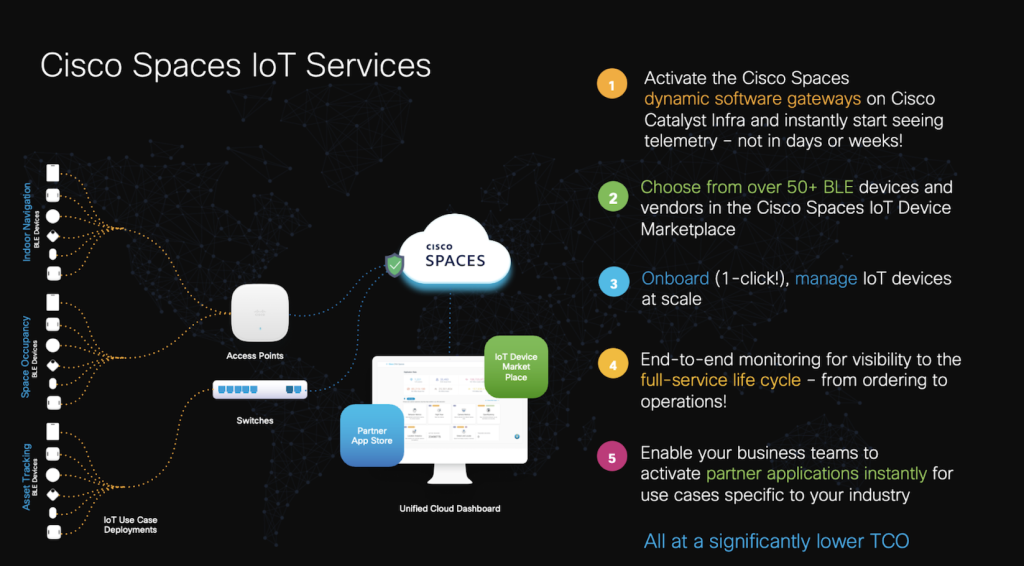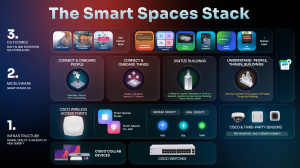
IoT applications are revolutionizing how businesses operate by paving the way for smarter, more responsive operational strategies. Let’s take a closer look at specific use cases and technologies that exemplify how IoT is making operations smarter, more efficient, and incredibly data-driven.
What Are IoT Applications?
The Internet of Things (IoT) encompasses a wide range of applications across various industries, leveraging connected devices to collect and analyze data, automate processes, and optimize performance. This connectivity provides real-time data for informed decision-making and transforming industries by enhancing efficiency, reducing operational costs, and driving innovation, thereby revolutionizing how businesses and societies operate.
Top Industries that Benefit from IoT Devices
Healthcare
In healthcare, IoT enables the real-time tracking of medical equipment, facilitates remote patient monitoring, and supports predictive maintenance, ensuring critical devices are operational when needed. These solutions significantly improve patient care by allowing continuous monitoring and timely interventions, reduce equipment downtime through preemptive maintenance alerts, and enhance operational efficiency by optimizing asset use and reducing unnecessary expenditures.
Manufacturing
In the manufacturing sector, IoT optimizes production processes by monitoring machinery performance in real-time, predicting maintenance needs, and managing energy consumption efficiently. These capabilities significantly reduce downtime by anticipating equipment failures before they occur, improve safety by monitoring for hazardous conditions, and ensure efficient resource allocation, leading to cost savings and enhanced productivity.
Logistics & Supply Chain
IoT technology enhances logistics and supply chain management by offering advanced fleet tracking, real-time inventory management, and route optimization, ensuring timely and efficient deliveries. These capabilities improve supply chain visibility, allowing companies to monitor goods in transit and in warehouses, thus reducing losses due to mismanaged inventory or delays.
Retail
In the retail sector, IoT applications facilitate smart inventory management. These technologies optimize stock levels and predict demand to minimize waste. By employing IoT, retailers can significantly enhance operational efficiency, providing a seamless shopping experience.
Eight Applications of IoT Technology for Smarter Operations
IoT stands as a transformative force for various industries, harnessing the power of interconnected devices to improve operational efficiency, reduce costs, and facilitate data-driven decision-making. Here are eight applications of IoT technology that showcase its versatility and impact on smarter operations:
1. Real-Time Asset Tracking
IoT-enabled asset tracking employs technologies such as GPS for location tracking and RFID for identification and status updates to monitor the whereabouts, condition, and utilization of assets in real time. In healthcare, this translates to efficient management of critical medical devices, ensuring they are always available and maintained when needed. In the logistics sector, it underpins advanced fleet management, optimizing routes and schedules, as well as inventory management, where it aids in minimizing loss and overseeing stock levels accurately. By providing instant visibility across various assets, IoT asset tracking enables organizations to make informed decisions, improving operational effectiveness and reducing risks associated with asset mismanagement.
2. Environmental Monitoring
IoT sensors dedicated to environmental monitoring are pivotal in tracking crucial factors such as air quality, temperature, and humidity, ensuring workspaces adhere to health, safety, and compliance standards. These sensors can efficiently detect deviations from set benchmarks in environments like offices, warehouses, and healthcare facilities, triggering real-time alerts to facility managers and employees. The instantaneous nature of this feedback allows for swift action to rectify any potential hazards or uncomfortable conditions, such as adjusting the HVAC system, thus maintaining a safe and productive workspace. Moreover, ongoing data collection aids in the analysis of environmental trends, further enhancing workplace safety and operational efficiency through proactive measures.
3. Predictive Maintenance
IoT systems, through the collection and analysis of data from various sensors attached to equipment, enable predictive maintenance by forecasting when machinery or devices might fail or require servicing. This approach significantly reduces downtime by addressing maintenance needs before actual breakdowns occur, thereby extending the lifespan of assets. For instance, factories utilize IoT technology to monitor the health and performance of machinery, preemptively identifying issues to prevent production halts. Similarly, in healthcare facilities, predictive maintenance ensures critical medical devices such as ventilators and diagnostic machines are operational and reliable when patients need them the most, maintaining high standards of care and safety.
4. Space & Occupancy Management
IoT sensors revolutionize space and occupancy management by providing real-time data on how spaces are utilized, enabling businesses to optimize layouts for efficiency and ensure compliance with safety regulations. In hybrid work environments, these sensors can track actual office usage, aiding in the design of workspaces that cater to fluctuating on-site presence. Similarly, facilities managing shared spaces, such as conference rooms, co-working spaces, or public institutions, benefit from IoT technology by dynamically adjusting access and resources based on occupancy data, ensuring a seamless experience for users and adherence to occupancy limits for safety and comfort. This intelligent use of space not only improves operational efficiency but also enhances user satisfaction and well-being.
5. Smart Energy Management
IoT solutions for smart energy management use real-time occupancy data to intelligently adjust HVAC systems, lighting, and other energy-consuming systems, ensuring that energy is used efficiently and only when needed. For example, in an office, lights and temperature can be automatically lowered in unoccupied areas, while in industrial facilities, machinery can be powered down during downtime. These responsive adjustments lead to significant reductions in energy consumption, which not only decreases operational costs but also enhances the sustainability profile of the business. By effectively balancing comfort, cost, and environmental impact, IoT-based smart energy management becomes an integral component of modern, eco-friendly, and cost-effective facility operations.
6. Inventory & Supply Chain Management
IoT technology plays a critical role in transforming inventory and supply chain management by offering real-time tracking of inventory levels and monitoring the supply chain’s various components. This enables predictive analytics for restocking, identifies bottlenecks, and optimizes logistics routes, significantly improving efficiency and reducing operational costs. In the retail sector, IoT devices ensure precise stock control, preventing overstocking or stockouts, and enhancing customer satisfaction through timely availability of products. Similarly, in logistics, IoT applications facilitate timely deliveries by optimizing route planning based on traffic and weather conditions, thereby reducing fuel costs and improving delivery efficiency. This comprehensive visibility and control over inventory and supply chains are instrumental in streamlining operations and supporting the sustainability of businesses.
7. Wearable IoT Devices for Worker Safety
Wearable IoT devices significantly enhance worker safety by continuously monitoring vital signs and exposure to hazardous conditions in real-time. These devices can detect abnormal heart rates, fatigue levels, and exposure to harmful substances, prompting immediate action to mitigate risks. For instance, in the construction industry, IoT devices can be used to monitor environmental conditions and alert workers to potential dangers, such as excessive heat or toxic gas concentrations. In healthcare settings, wellness monitors worn by staff track stress levels and physical strain, ensuring that those providing care remain healthy and alert. This proactive approach to monitoring health and safety parameters not only safeguards worker well-being but also promotes a culture of safety and prevention in the workplace.
8. Remote Monitoring & Control
IoT technology empowers facilities managers to remotely monitor and control critical building systems such as lighting, HVAC, and security, directly from their smartphones or computers. This capability is invaluable for maintaining operational continuity, especially during off-site hours or in scenarios where facilities are spread across multiple locations. It enables real-time adjustments to systems, ensuring that energy is not wasted on lighting unoccupied spaces or heating empty rooms, and that security systems are always activated when needed. The ability to remotely manage these systems not only reduces operational costs but also enhances the efficiency and security of facilities, ensuring a seamless and adaptive operational environment regardless of the physical presence of management staff.
Why Choose Cisco Spaces for Smarter Operations?
Cisco Spaces leverages the strength of existing Cisco infrastructure. No additional gateways are required and this further facilitates seamless deployment. Its array of features, including real-time asset tracking, environmental monitoring, and occupancy management, simplifies complex operations and significantly reduces operational costs. Furthermore, Cisco Spaces is designed for compatibility, allowing it to integrate smoothly with a wide range of existing systems. This ensures businesses can adopt IoT solutions in a scalable and cost-effective manner, enhancing efficiency without necessitating substantial upfront investments. By providing a comprehensive toolkit for smarter operations, Cisco Spaces stands out as an optimal choice for businesses looking to harness the power of IoT technology.
Transform Operations with Cisco Spaces
IoT technology is revolutionizing industries by enabling smarter operations, greater efficiency, and enhanced decision-making capabilities. Through real-time asset tracking, environmental monitoring, and occupancy management, businesses can automate and optimize processes like never before. Cisco Spaces is at the forefront of this transformation, offering a seamless, scalable platform that simplifies IoT deployment across diverse environments, from healthcare and manufacturing to retail and hospitality.
Cisco Spaces stands out by turning your existing Cisco hardware into powerful IoT sensors, streamlining deployment and reducing costs. With features such as panic alerting in healthcare facilities, environmental monitoring for temperature-sensitive supplies, and comprehensive asset tracking across multiple sectors, the platform empowers organizations to maintain operational continuity and safety while driving down expenses.
Explore the versatile capabilities and see how Cisco Spaces can transform your operations today.


